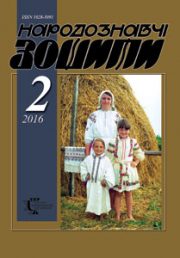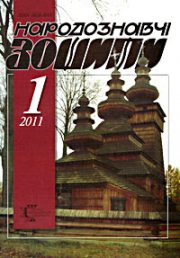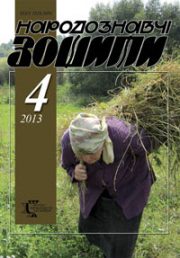The Ethnology Notebooks. 2019, № 5 (149), 1102—1122
UDK 801.73/.8:398.2(=161.2=162.1)(091):929.732(438)Л.Шептицький
DOI https://doi.org/10.15407/nz2019.05.1102
LUNIO Eugene
ORCID ID: https://orcid.org/0000-0002-1543-7008
Candidate of Philology,
Institute of Ethnology
National Academy of Sciences of Ukraine,
Research Fellow, Department of Folklore,
15, Svobody ave., 79000, Lviv, Ukraine
e-mail: lunyoe@gmail.com
Abstract. Formulation of the problem. Today for Ukraine, in the face of real and potential interethnic conflicts, relations with neighboring nations and states, including Poland, are important. For their successful development, it is important to consider the positive and negative aspects of the historical experience.
The object of the study is a multi-genre folk-epic story, the subject is the reflection and comprehension in them of the family of Polish Count Leon Sheptytsky.
The purpose of the article. In the folklore aspect, through the prism of folk-epic reflection and comprehension of reality, we aim to explore the religious, linguistic and national identity of their practical activity and expression in this regard. Analysis of the research. The proposed article is the first study in Ukrainian folklore studies. The methodological basis is the method of hermeneutics as the art of understanding textual discourse, as well as as commenting on and interpreting a work of art through a mental-analytical and intuitive comprehension of its artistic meaning.
The narrative tradition in the religious aspect presents the family of Count Leon Sheptytsky as ardent Roman Catholics. However, they also attended Greek Catholic worship services, which on the one hand were caused by close family relations with Metropolitan Andrew, and on the other, to earn respect from local peasants. The speech practice of landowner Leon Sheptytsky and his family is covered and reflected. Despite some cases of communication with the local population in the Ukrainian language, Polish was their basic language. On the issue of nationality, it is stated on the basis of a reflection on the statements and actions of Leon and Yadviga Sheptytsky that they were Polish in both ethnic and political sense.
Keywords: narrative tradition, Leon Sheptytsky, Metropolitan Andrey Sheptytsky, Ukrainian-Polish relations, Yavoriv region.
Received 1.10.2019
REFERENCES
Bubis, D. (2005). Prylbychi. Through the prism of ages (historical sketch). Lviv: Gerdan Grafika [in Ukrainian].
Lunio, E. (2015). Andrey Sheptytsky’s Youth in the Epic Tradition of His Family Village. Materials of the 5th All-Ukrainian Conference «State and Church in the Recent History of Ukraine» (Pp. 137—146). Poltava National Pedagogical University named after Korolenko. Poltava [in Ukrainian].
Baidovych, S. (Volyansky Omelyan-Semen). (1951, January). Krakowiec, the birthplace of T. Chuprynka. America, 12, 13, 14, 18, 22, 23. Philadelphia [in Ukrainian].
Volosyansky, S., & Sova, A. (2019). Krakowiec, the birthplace of T. Chuprynka. Roman Shukhevych in the Social and Political Life of Western Ukraine 1920—1939: Memories, Documents, Pictures (Pp. 39—44). Center for Independent Historical Studies. Lviv: Apriori [in Ukrainian].
Matkovsky, I. (2019). Casimir Count Sheptytsky — Father Clementius: Polish aristocrat, Ukrainian hieromonk, Exarch of Russia and Siberia, Archimandrite Studitov, Righteous people of the world, blessed Catholic Church: monograph. Lviv [in Ukrainian].
National Gazette, 267 (1895, 26 September) [in Polish].
Gronsky, J. (2008). An outline of the history of the Yavoriv region. Drohobych: Circle. Second edition. Corrected, supplemented [in Ukrainian].
Truhan, M. (1992). Negative stereotype of Ukrainian in Polish post-war literature. Lviv: Troyan [in Ukrainian].
Zashkilnyak, L., & Krykun, M. (2002). History of Poland: From ancient times to the present day. Lviv: Lviv National University named after I. Franko [in Ukrainian].
Matkovs’kyi, I. & Boyko, Yu. (Eds.). (2017). Blessed Archimandrite Clement (Count Casimir Sheptytsky). Letters to his brother Stanislav Count Sheptytsky and family. Lviv [in Ukrainian].
Sheptytska from Fredry S. (1994). Youth and vocation Fr. Roman Sheptytsky. Lviv: Svichado [in Ukrainian].
Lypa, Y. (1984). Yavoriv and Yavorivshchyna (The first and third letters from the «Province» cycle). Yavorivshchyna and Krakowoczyn. Regional historical and memoir collection (Pp. 580—585). Scientific Society. Shevchenko. New York; Paris; Sydney; Toronto [in Ukrainian].
Liskevych-Karpa, M. (2010). Dukla Fortress — Bruchnal Township — Ternovytsa Village: An Historical and Local History Sketch. Lviv: Logos [in Ukrainian].
To the eternal shame of Poland, the stronghold of barbarism in Europe. (1956). The second unaltered edition. New York: Goverla [in Ukrainian].
Lenzyk, V. (2004). Prominent figures of the Ukrainian Church: Metropolitan Andrey Sheptytsky and Patriarch Joseph Slipy. Lviv: Svichado [in Ukrainian].
Babiak, A., Kyrychuk, O., Omelchuk, M., & Orlevych., I. (Eds.). (2015). Key stages in the life of the spiritual leader of the Ukrainian people, Metropolitan Andrey Sheptytsky (1865—1944). Ukrainian Moses (to the 150th Anniversary of the Birth of Metropolitan of the Ukrainian Greek Catholic Church Andrei Sheptytsky): Articles and Materials (Pp. 7—10). Lviv: Publishing Department of the Lviv Museum of the History of Religion «Logos» [in Ukrainian].
Zemba, A., & Galiv, M. (Ed.). (1996). Metropolitan Andrey Sheptytsky and the government of the Second Ricz Pospolyta in 1923—1939. Metropolitan of New York to the servant of God Andrew in the fiftieth anniversary of his death (Pp. 36—51). New York [in Ukrainian].






